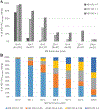Measuring Disease Damage and Its Severity in Childhood-Onset Systemic Lupus Erythematosus
- PMID: 29409150
- PMCID: PMC12476143
- DOI: 10.1002/acr.23531
Measuring Disease Damage and Its Severity in Childhood-Onset Systemic Lupus Erythematosus
Abstract
Objective: To describe the frequency and types of disease damage occurring with childhood-onset systemic lupus erythematosus (SLE) as measured by the 41-item Systemic Lupus International Collaborating Clinics/American College of Rheumatology Damage Index (SDI), and to assess the SDI's ability to reflect damage severity.
Methods: Information for the SDI was prospectively collected from 1,048 childhood-onset SLE patients. For a subset of 559 patients, physician-rated damage severity measured by visual analog scale (MD VAS damage) was also available. Frequency of SDI items and the association between SDI summary scores and MD VAS damage were estimated. Finally, an international consensus conference, using nominal group technique, considered the SDI's capture of childhood-onset SLE-associated damage and its severity.
Results: After a mean disease duration of 3.8 years, 44.2% of patients (463 of 1,048) already had an SDI summary score >0 (maximum 14). The most common SDI items scored were proteinuria, scarring alopecia, and cognitive impairment. Although there was a moderately strong association between SDI summary scores and MD VAS damage (Spearman's r = 0.49, P < 0.0001) in patients with damage (SDI summary score >0), mixed-effects analysis showed that only 4 SDI items, each occurring in <2% of patients overall, were significantly associated with MD VAS damage. There was consensus among childhood-onset SLE experts that the SDI in its current form is inadequate for estimating the severity of childhood-onset SLE-associated damage.
Conclusion: Disease damage as measured by the SDI is common in childhood-onset SLE, even with relatively short disease durations. Given the shortcomings of the SDI, there is a need to develop new tools to estimate the impact of childhood-onset SLE-associated damage.
© 2018, American College of Rheumatology.
Figures


References
-
- Gladman D, Ginzler E, Goldsmith C, Fortin P, Liang M, Urowitz M, et al. The development and initial validation of the Systemic Lupus International Collaborating Clinics/American College of Rheumatology damage index for systemic lupus erythematosus. Arthritis Rheum 1996;39:363–9. - PubMed
-
- Gladman D, Urowitz MB. The SLICC/ACR damage index: progress report and experience in the field. Lupus 1999;8:632–7. - PubMed
-
- Becker-Merok A, Nossent HC. Damage accumulation in systemic lupus erythematosus and its relation to disease activity and mortality. J Rheumatol 2006;33:1570–7. - PubMed
-
- Brunner HI, Silverman ED, To T, Bombardier C, Feldman BM. Risk factors for damage in childhood-onset systemic lupus erythematosus: cumulative disease activity and medication use predict disease damage. Arthritis Rheum 2002;46:436–44. - PubMed
-
- Livingston B, Bonner A, Pope J. Differences in autoantibody profiles and disease activity and damage scores between childhood- and adult-onset systemic lupus erythematosus: a meta-analysis. Semin Arthritis Rheum 2012;42:271–80. - PubMed
Publication types
MeSH terms
Grants and funding
LinkOut - more resources
Full Text Sources
Other Literature Sources
Medical

